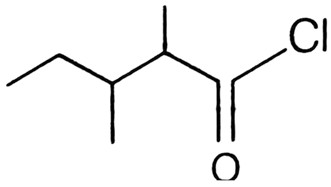 Multiple Choice Questions
Multiple Choice Questions1-butyne on oxidation with hot alkaline KMnO4 would yield. Which of the following as end product?
CH3CH2CH2COOH
CH3CH2COOH
CH3CH2CH2COOH + CO2 + H2O
CH3CH2CH2COOH + HCOOH
A cubic unit cell of a metal with a molar mass of 63.55 g mol-1 has an edge length of 362 pm. Its density is 8.92 g cm-3. The type of unit cell is
Primitive
Face centred
End centred
Body Centred
Which of the following is the major product in the reaction of HOBr with propene?
2-bromo, 1-propanol
3-bromo,1-propanol
2-bromo, 2-propanol
1-bromo, 2-propanol
Which of the following is the correct IUPAC name?

3,4 -dimethyl pentanoyl chloride
1-chloro-1-oxo-2, 3-dimethyl pentane
2-ethyl-3-methyl butanoyl chloride
2,3-dimethyl pentanoyl chloride
The pair of boiling point and compound are given as,
C6H6 (80C); CH3OH (65C); C6H5NO2 (212C) and C6H5NH2 (184C)
Which will show lowest vapour pressure at room temperature?
C6H6
CH3OH
C6H5NO2
C6H5NH2
In the following conversion,

Identify 'A' from the following option
NaBD4
LiAID4
Mg, ether/D2O
BH3, D2O
Ethers like ROR can be cleaved by concentrated HI but not by HCl because
I- is a weaker nucleophile than Cl-
I- is stronger nucleophile than Cl-
SN1 mechanism carried out in this reaction is rapidly in presence of HI.
None of the above
Consider the following reaction sequence
CH3OH 'A' 'B' 'C' 'D'
Choose the correct option regarding the different products obtained in the above reaction sequence:
'D' is an alcohol consisting one carbon more than the starting alcohol
Product 'B' is formed via SN2-pathway
'C' is an amine
All of the above
The relative reactivities of acyl compounds towards nucleophilic substitution are in the order of
acyl chloride > acid anhydride > ester > amide
ester > acyl chloride > amide > acid anhydride
acid anhydride > amide > ester > acyl chloride
acyl chloride> ester> acid anhydride > amide
